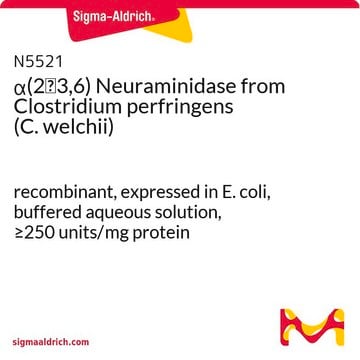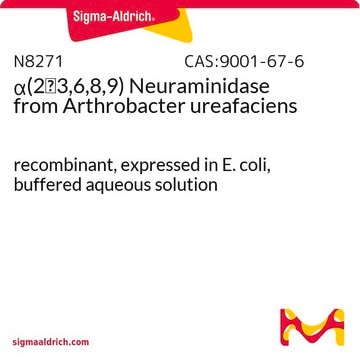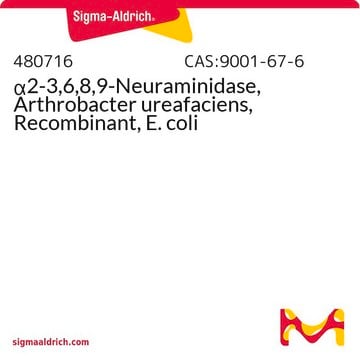N2133
Neuraminidase from Clostridium perfringens (C. welchii)
Type X, lyophilized powder, ≥50 units/mg protein (using 4MU-NANA)
Sinónimos:
Acyl-neuraminyl Hydrolase, Receptor-destroying enzyme, Sialidase
About This Item
Productos recomendados
tpo
Type X
Nivel de calidad
formulario
lyophilized powder
actividad específica
≥50 units/mg protein (using 4MU-NANA)
temp. de almacenamiento
−20°C
Información sobre el gen
Clostridium perfringens str. 13 ... nanI(988807)
¿Está buscando productos similares? Visita Guía de comparación de productos
Descripción general
Aplicación
Acciones bioquímicas o fisiológicas
Definición de unidad
Nota de preparación
Nota de análisis
Palabra de señalización
Danger
Frases de peligro
Consejos de prudencia
Clasificaciones de peligro
Resp. Sens. 1
Código de clase de almacenamiento
11 - Combustible Solids
Clase de riesgo para el agua (WGK)
WGK 1
Punto de inflamabilidad (°F)
Not applicable
Punto de inflamabilidad (°C)
Not applicable
Equipo de protección personal
Eyeshields, Gloves, type N95 (US)
Certificados de análisis (COA)
Busque Certificados de análisis (COA) introduciendo el número de lote del producto. Los números de lote se encuentran en la etiqueta del producto después de las palabras «Lot» o «Batch»
¿Ya tiene este producto?
Encuentre la documentación para los productos que ha comprado recientemente en la Biblioteca de documentos.
Los clientes también vieron
Artículos
Understand sialic acid structure, function, signaling, and modifications. Easily find products for sialic acid research.
Protocolos
Enzymatic Assay of Neuraminidase applies to products that have a specification for neuraminidase content by enzymatic determination.
Nuestro equipo de científicos tiene experiencia en todas las áreas de investigación: Ciencias de la vida, Ciencia de los materiales, Síntesis química, Cromatografía, Analítica y muchas otras.
Póngase en contacto con el Servicio técnico











